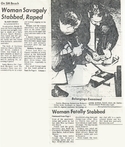McGuire, now 44, was convicted on April 23, 2007, of murder, possession of a weapon for unlawful purpose, desecration of of human remains and perjury in connection with the death of her husband, whose body parts were recovered from a set of matching black and green Kenneth Cole "Reaction" suitcases pulled from Chesapeake Bay near Virginia Beach in May 5, 2004, just days after he had allegedly gone missing from the couple's Woodbridge home. Days earlier, the couple had purchased a $500,000 home in Warren County.
William McGuire died from two gunshots wounds — one to the head and one to the chest. Melanie McGuire was charged with his murder in June 2005, more than a year after her husband's remains had been found.
Following a televised trial and conviction, she was sentenced to life in prison and must serve 85 percent before becoming eligible for parole.
McGuire sought post-conviction relief in 2014, claiming in court papers that she was denied effective representation by famed attorney Joseph Tacopina.

